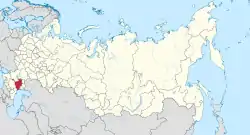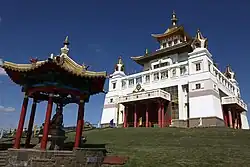Buddhism in Kalmykia
The Kalmyk people are the only Mongolic-speaking people of Europe whose national religion is Buddhism.[1] In 2016, 53.4% of the population surveyed identified themselves as Buddhist.[2] They live in Kalmykia, a federal subject of the Russian Federation located in southwestern Russia. The border faces Dagestan to the south, Stavropol Krai to the southwest, Rostov Oblast to the west, Volgograd Oblast to the northwest and Astrakhan Oblast to the east. The Caspian Sea borders Kalmykia to the southeast.

_p307_Kalmyk_people_in_a_buddhist_ceremonie.jpg.webp)
| Part of a series on |
| Buddhism |
|---|
.svg.png.webp) |
The Kalmyks are the descendants of Oirats who migrated to Europe during the early part of the 17th century. As Tibetan Buddhists, the Kalmyks regard the Dalai Lama as their spiritual leader.[3] The Šajin Lama (Supreme Lama) of the Kalmyks is Erdne Ombadykow, a Philadelphia-born man of Kalmykian origin who was brought up as a Buddhist monk in a Tibetan monastery in India from the age of seven. Ombadykow was appointed to this position by the 14th Dalai Lama in 1992, who identified him as the reincarnation of the Buddhist saint Telo Rinpoche.[4] Ombdaykow divides his time between living in Colorado and living in Kalmykia.
Kalmyk political refugees opened the first Buddhist temple in Central Europe, the Belgrade pagoda, located in Belgrade, Serbia, in 1929. In the wake of the Second World War, an estimated 526 Kalmyk refugees migrated from West Germany and surrounding areas to America in the late 1951 and early 1952.[5] By 1962, the approximate Kalmyk population in the United States was 700.[5] There, they established several Kalmyk Buddhist temples in Monmouth County, New Jersey and its environs. Ngawang Wangyal, a Kalmyk Buddhist monk, established the Tibetan Buddhist Learning Center and monastery in Washington, New Jersey.[6]
The babushki matsik
The babushki matsik (matsg), meaning "group of old women precept holders" were groups of elderly women who perpetuated traditional Tibetan Buddhist practices during the forced deportation of Kalmyk nationals to Siberia in 1943.[4] This followed a period in the 1930s of the arrests and persecution of the Buddhist clergy under the Stalinist regime.[7] During this period, all Kalmyk Buddhist shrines and temples were demolished.[7] The babushki matsik are increasingly recognised for their role in preserving translated Tibetan Buddhist sacred texts, advantageously using their "politically negligible" status as old women to create untouchable religious material that could then be recorded and dispersed in periods of religious freedom.[4]
See also
References
- Balinova, Natalia; Post, Helen; Kushniarevich, Alena; Flores, Rodrigo; Karmin, Monika; Sahakyan, Hovhannes; Reidla, Maere; Metspalu, Ene; Litvinov, Sergey; Dzhaubermezov, Murat; Akhmetova, Vita; Khusainova, Rita; Endicott, Phillip; Khusnutdinova, Elza; Orlova, Keemya (September 2019). "Y-chromosomal analysis of clan structure of Kalmyks, the only European Mongol people, and their relationship to Oirat-Mongols of Inner Asia". European Journal of Human Genetics. 27 (9): 1466–1474. doi:10.1038/s41431-019-0399-0. ISSN 1476-5438.
- "На тюменском севере каждый десятый готов взять в руки оружие". www.znak.com. Retrieved 2021-04-09.
- "Regions and territories: Kalmykia". 2011-11-29. Retrieved 2021-04-09.
- Lekshe Tsomo, Karma (2016). "Prayers of Resistance: Kalmyk Women's Covert Buddhist Practice". Nova Religio: The Journal of Alternative and Emergent Religions. 20: 91.
- "The American Kalmyks". The Mongolia Society Newsletter. 1 (1): 6–8. 1962. JSTOR 43194607.
- "Tibetan Buddhist Learning Center". Retrieved 2021-04-09.
- Fedorov, Gleb; RIR (2014-08-20). "The Soviet Union's repression of Buddhism". www.rbth.com. Retrieved 2021-04-09.
Further reading
- Seth Mydans, An Ex-Telemarketer's Other Life as a Buddhist Saint, The New York Times, 12 June 2004
- Sinclair, Tara (2008). Tibetan Reform and the Kalmyk Revival of Buddhism, Inner Asia 10(2), 241-259
- Ulanov, Mergen; Badmaev, Valeriy and Holland, Edward (2017). Buddhism and Kalmyk Secular Law in the Seventeenth to Nineteenth Centuries, Inner Asia 19(2), 297–314
